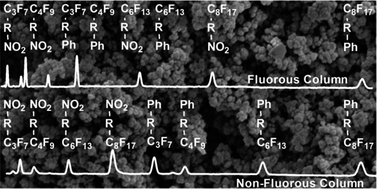This is the first report on the CEC separation of fluorous analytes on a fluorous porous polymer monolith (FPPM) stationary phase based on fluorous–fluorous interaction. Monolithic columns do not require retaining frits and can be conveniently photo-patterned within a capillary. Two groups of fluorous compounds, a N-f-Cbz-4-nitro-benzylamine (N) series and a N-f-Cbz-4-phenyl-benzylamine (P) series, each series having compounds differing only by the length of their perfluorinated tag, were employed to evaluate the ability of the fluorinated column to separate fluorous analytes using a variety of mobile phase compositions and separation conditions. Fluorous monoliths showed enhanced separation performance by providing better selectivity, higher resolution and shorter analysis time compared to a similar non-fluorous (reversed phase) monolithic column. Under optimal conditions, column efficiency as high as 234 000 plates per metre was achieved, and all four compounds of the N series were fully resolved in <5 minutes. Perfluoromethylene selectivity was used to quantitatively evaluate the interaction between the perfluorinated chain on the analytes and both the FPPM and non-FPPM columns. It was found that the non-FPPM column resolves fluorous analytes mainly based on reversed phase interaction while the FPPM column resolves them mainly based on fluorous–fluorous interaction. Results are compared to fluorous monolith columns used in a nano-liquid-chromatographic (nano-LC) separation with gradient elution. The FPPM column required less than one fifth the analysis time in CEC mode than was required in nanoLC mode, with superior separation efficiency and resolution. FPPM stationary phases provide an attractive option for the analysis of perfluorinated analytes, which is expected to be useful in areas such as proteomics for the separation of fluorously tagged proteins, and in environmental analysis where fluorinated species are of increasing concern.

You have access to this article
 Please wait while we load your content...
Something went wrong. Try again?
Please wait while we load your content...
Something went wrong. Try again?


 Please wait while we load your content...
Please wait while we load your content...